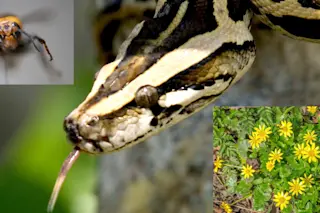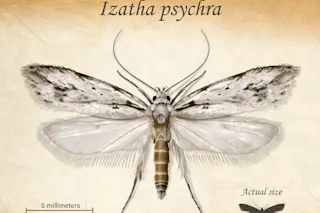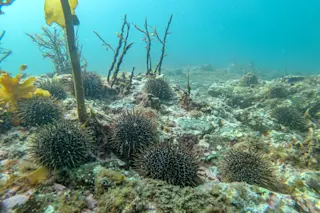Ants, bees, termites, and wasps were long thought to be the only animals that live eusocially--that is, they form communities of overlapping generations in which cooperative care of the young, common defense, and a breeding queen are the norm. Naked mole rats later joined their ranks as the only known eusocial mammals. And last spring, marine biologist J. Emmett Duffy of the College of William and Mary in Virginia added Synalpheus regalis, a newly discovered species of snapping shrimp, to the eusocial register, the first marine species to have that distinction.
Many species of snapping shrimp--so named for their outsize fighting claw--are known. The species Duffy discovered is about half an inch long and lives in the nooks and crannies inside sea sponges in the Caribbean, feeding on the microscopic plants and other material in seawater that the sponge continually siphons in. For an ecological study, Duffy was collecting some of these sponges from a coral reef 50 feet underwater off the coast of Belize. While I was doing that study, Duffy says, I noticed that some species had only a single female per sponge. That made me very curious about the social aspects of these animals.
He proceeded to collect more than 30 sponges. Each housed a colony of S. regalis, some with as many as 313 shrimps of different generations. We found several groups of uniformly sized animals, apparently each a different clutch of babies born together, says Duffy. The single female in each colony was often twice as large as any male shrimp in the colony.
Genetic analysis revealed that most colony members were offspring of one large queen and probably just one or two mating males. Many of the larger males, says Duffy, seem not to reproduce and serve only as defenders, a social organization similar to that of colonial insects. In his lab, Duffy removed adult shrimps from a colony and then reintroduced them to the colony the next day to see if defenders would recognize the shrimps or attack them as invaders. The defenders never harmed these reintroduced shrimps but invariably killed introduced shrimps of different species.
Duffy doesn’t know how new colonies of the shrimps get started. He speculates that occasionally one or several juveniles may leave the nest. Once free of the influence of their former queen, one of the larger males may change into a female and start a new brood. Such sex changes are common among shrimp species. Duffy believes communal living and cooperative defense probably help increase the shrimps’ chances of survival, as well as improve the likelihood that their genes will pass to a new generation. With these advantages, eusociality may be more common than researchers had thought. I think there are more eusocial animals out there like these shrimps--small, inconspicuous animals, he says, and we just haven’t seen them yet.














